By Carl Zulauf
Department of Agricultural, Environmental and Development Economics
Ohio State University
and
Jonathan Coppess, Krista Swanson, Gary Schnitkey, Nick Paulson
Department of Agricultural and Consumer Economics
University of Illinois
The Agriculture Improvement Act of 2018 authorizes a program decision for the 2019 and 2020 crops of a covered commodity. This article provides an early overview of the decision-making framework with a focus on fairness across covered commodities, particularly corn, soybeans, and wheat.
Market Price-ERP (Effective Reference Price) Relationship
The PLC (Price Loss Coverage) program option makes payments only if MYA (marketing year average) price is below ERP. Thus, a key program decision factor is the relationship between a covered commodity’s expected MYA price and ERP. Assuming a simple forecast that 2019 MYA price is the currently projected 2018 MYA price, expected 2019 MYA price ranges from 23% under ERP for long-grain rice to 51% above ERP for sesame seed (see Figure 1, Appendix Table 1, and Data Note 1). Corn, soybean, and wheat MYA price is 4% under, 2% over, and 6% under ERP, respectively, as of March 2018. Only 1 other covered commodity (dry peas) is within their range of values. Ten covered commodities have a MYA price that is 13% or more under ERP. The lower is MYA price compared to ERP, the more likely will a PLC payment be triggered. As of March 2018, this simple forecast analysis suggests corn, soybeans, and wheat will have a closer program decision than most other covered commodities and that it will be critically impacted by how demand and supply evolve over the 2019 production period. Small decreases in supply or small increases in demand could eliminate 2019 PLC payments for corn, soybeans, and wheat. Alternatively, the likelihood of PLC payments will increase if supply and demand changes for these crops lead to lower prices. Other key program decision factors include that: (1) ARC (Agriculture Risk Coverage) program option, but not PLC, pays on yield variation, (2) PLC pays over a wider, often much wider, range of MYA prices as ARC payments are limited to 10% of its benchmark revenue while PLC payments are bounded by the lower US loan rate, and (3) PLC payments start at 100% of ERP while ARC payments start at 86% of benchmark revenue.

Price Resolution
The previous section prompts the question, “How much does history suggest will be known about 2019 MYA corn, soybean, and wheat price by the time program sign up ends?” To gain perspective, a percent difference is calculated for each month between a projected MYA price based on monthly prices released by NASS (National Agricultural Statistics Service) and the year’s final MYA price. The analysis covers the 2002-2017 marketing years, the period for which data are available electronically. See Data Notes 2, 3, and 4 for more discussion of this calculation.
Standard deviation of the percent differences by marketing year is calculated for each month. This standard deviation is a measure of price uncertainty about MYA price. Price uncertainty should decline as a marketing year progresses. Corn, soybeans, and wheat conform to this expected time path (see Figures 2–4). When compared by month since the start of the marketing year, magnitude of price uncertainty is more similar for corn and wheat than for soybeans. Soybeans’ lower price uncertainty reflects its different supply and demand characteristics, with an important characteristic likely being soybeans’ more elastic demand.
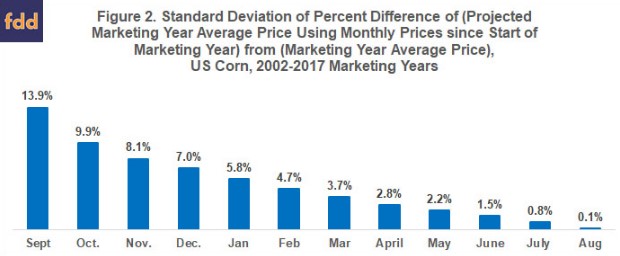
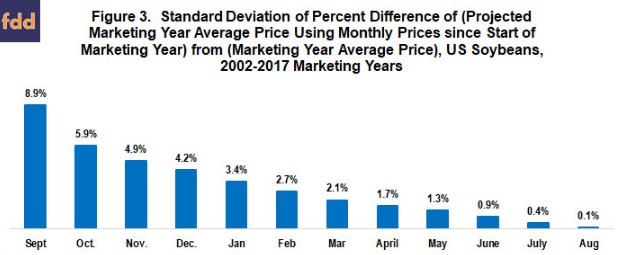
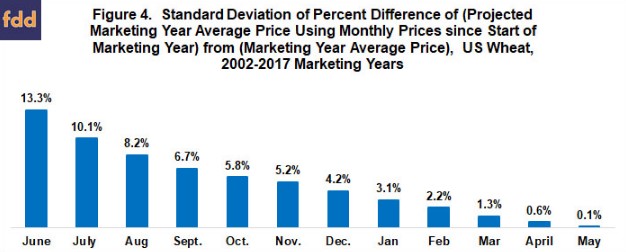
FSA (Farm Service Agency) has historically used the same sign up period for all covered commodities. Thus, Figure 5 compares price uncertainty as of October through May. Because NASS releases prices for the prior month at the end of a month (for example, at the end of March 2019 NASS will release the price for February 2019), the price uncertainty for October in Figure 5 is the September price uncertainty for corn, soybeans, and wheat in Figures 2-4 (as another example, price uncertainty for May in Figure 5 is price uncertainty for April in Figures 2-4). Over the October-May period, price uncertainty is always highest for corn. Price uncertainty is usually lowest for wheat but sometimes for soybeans. Wheat’s smaller price uncertainty than corn reflects wheat’s earlier harvest.
To illustrate interpretation of Figure 5 and the standard deviation, assume expected MYA price for corn is $3.55 and for wheat is $5.15. As of October, the historical standard deviation implies the 95% confidence interval for corn’s MYA price is $2.56 ($3.55 – ($3.55 X 13.9% X 2) to $4.54 ($3.55 + ($3.55 X 13.9% X 2), or a range of $1.98 (in words, 95% confidence is minus and plus 2 times standard deviation). In comparison, 95% confidence interval for wheat’s MYA is smaller: $4.46 ($5.15 – ($5.15 X 6.7% X 2) to $5.84 ($5.15 + ($5.15 X 6.7% X 2), or a range of $1.38.
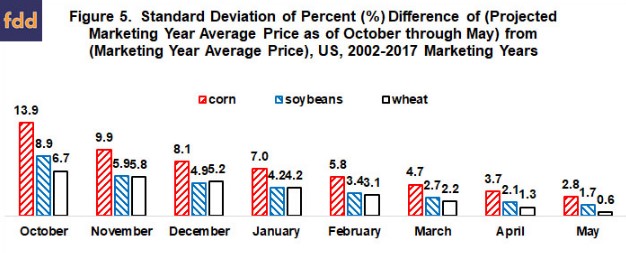
The similarity of price uncertainty is one measure of fairness across covered commodities at sign up. The more similar is price uncertainty across covered commodities the more similar the price forecasting situation for the covered commodities. Figure 6 thus presents the range of price uncertainty for corn, soybeans, and wheat by month from October through May. To illustrate this calculation for October, the range of price uncertainty is 7.2% (percentage points) (13.9% for corn – 6.7% for wheat – see Figure 5). The range declines for all subsequent months but the decline levels off to 0.1 to 0.2 percentage points per month after January. A potential implication is that the 2019-2020 sign up period should not end until at least January 31, 2020.
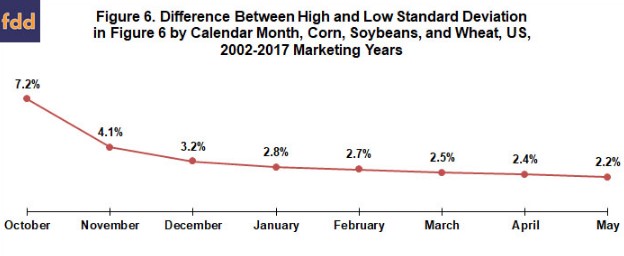
The preceding recommendation only considers the difference in price uncertainty. Another measure of fairness is the magnitude of price uncertainty. As conveyed by Figures 2-4, equating the magnitude of price uncertainty across covered commodities at the end of sign up would require having different ending months by covered commodity for program sign up. For example, having a target price uncertainty of no more than 2% would imply an end to sign up of June 30 for corn (Figure 2), April 30 for soybeans (Figure 3), and March 31 for wheat (Figure 4).
Summary Observations
- Current evidence suggests the 2019-2020 program decision for corn, soybeans, and wheat will likely be closer than for most other covered commodities.
- A close decision implies a strategy of waiting to make it, thus maximizing known information.
- This strategy will likely increase farm program payments because farms become more likely to pick the program that pays the most. Economists refer to this outcome as adverse selection.
- Support for a strategy of waiting is the decline in uncertainty surrounding MYA price as a covered commodity’s marketing year progresses.
- This expected price resolution path raises a potentially important fairness issue: some crops have an information advantage.
- If the 2019-2020 sign up takes the historical approach of a common sign up period, this analysis suggests the fairness issue, as measured by the remaining uncertainty surrounding 2019 MYA price for corn, soybeans, and wheat, will be reduced by ending sign up after January 31, 2020, everything else the same.
- Another fairness measure is to end sign up at roughly the same target level of price uncertainty for MYA price. This measure would require that the end of sign-up be customized by covered commodity.
- Objective of this article is not to solve the issue of a “fair farm program sign-up period across covered commodities.” Instead, it is to point out its importance and to suggest some possible measures to gain perspective on how to manage this issue.
- Looking further ahead, the 2018 farm bill makes the issue of a “fair farm program sign-up period across covered commodities” more important by authorizing annual sign-ups beginning with the 2021 marketing year.
Data Notes
- For corn, soybeans, and wheat; ERP equals the higher of (a) statutory reference price (reference price stated in 2018 farm bill) for the covered commodity or (b) an escalator option of 85% of Olympic average price of the covered commodity for the 5 most recent marketing years (excludes high and low price), but (c) cannot exceed 115% of statutory reference price. Source for the statutory reference price and 2014-2018 MYA prices used to calculate 2019 ERP is the US Department of Agriculture (USDA), FSA website. ERP is not calculated for temperate Japonica rice because it is not clear at present what data will be used to implement the 2018 farm bill provision concerning its ERP. For additional discussion of ERP in the context of the 2019 marketing year, see the farmdoc daily article of February 21, 2019.
- USDA, NASS computes the MYA price using the average price for a month and share marketed during that month. At the end of each month NASS releases the average price for the prior month. Share of production marketed each month is released after the marketing year ends. These data are available from NASS’s Quickstats website starting with the 2002 marketing year. The marketing year starts June 1 for wheat and September 1 for corn and soybeans.
- A projected MYA price is estimated for each month using monthly prices since the marketing year started and share of production marketed by month. To illustrate, estimated MYA price as of the 2nd month of a marketing year is calculated: [(price for month 1 times (share marketed in month 1 divided by sum of shares marketed in months 1 and 2)) plus (price for month 2 times (share marketed in month 2 divided by sum of shares marketed in months 1 and 2))]. The estimate is thus a weighted average of monthly prices, where the weight is share of crop marketed so far by month. As a numeric example, US soybean price and share sold for September and October 2017 were, respectively, $9.35 and $9.18, and 7% and 26%. Plugging these numbers into the equation: [($9.35 X (7% / (7%+26%))) + ($9.18 X (26% / (7%+26%)))] which equals $9.22.
- Percent difference is calculated: [{projected MYA price as of a month (see Data Note 3) minus final MYA price) divided by final MYA price)]. To continue with the same example in Data Note 2 and given that 2017 final MYA price for US soybeans was $9.33, percent difference for October 2017 is [($9.22-$9.33)/$9.33)], which equals -1.2%. Thus, the projected MYA price using data for September and October 2017 differs from the 2017 final MYA price by -1.2%.
Source:farmdocdaily